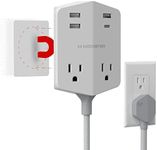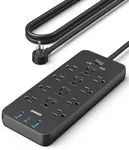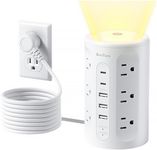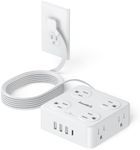Buying Guide for the Best TV Surge Protector
Choosing the right surge protector for your TV is important to keep your electronics safe from unexpected power surges, which can happen during storms or due to electrical issues in your home. A good surge protector not only shields your TV but can also protect other connected devices like sound systems or gaming consoles. When shopping for a surge protector, it's important to understand the key features that determine how well it will protect your equipment and how convenient it will be for your setup.Joule RatingThe joule rating tells you how much energy the surge protector can absorb before it stops protecting your devices. Think of it as the protector’s capacity to take hits from power surges. Lower ratings (around 200-600 joules) offer basic protection and are suitable for small devices, while medium ratings (600-1200 joules) are better for TVs and home entertainment systems. Higher ratings (over 1200 joules) provide more robust protection, ideal for expensive or sensitive electronics. If you want to protect a valuable TV or multiple devices, aim for a higher joule rating.
Number of OutletsThis spec tells you how many devices you can plug into the surge protector at once. Some have just a few outlets, while others offer six, eight, or even more. If you only need to protect your TV, a few outlets may be enough. But if you have a full entertainment setup with a soundbar, streaming box, and game console, look for a surge protector with enough outlets for all your devices. Always consider your current needs and any future additions.
Clamping VoltageClamping voltage is the voltage level at which the surge protector will start to block or divert excess electricity. Lower clamping voltages (like 330V) mean the protector reacts sooner to surges, offering better protection. Higher clamping voltages (like 400V or 500V) may let more surge energy through before activating. For sensitive electronics like TVs, a lower clamping voltage is generally better, so look for this information in the product details.
Response TimeResponse time is how quickly the surge protector reacts to a power surge. Faster response times (measured in nanoseconds) mean your devices are exposed to less surge energy. Most modern surge protectors have very fast response times, but if you see this spec listed, a lower number is better. For most home users, as long as the response time is under a nanosecond, it will be sufficient.
Indicator LightsMany surge protectors have indicator lights that show whether the protection is active and if the outlets are grounded. This is important because surge protectors can wear out over time, and the lights let you know if it’s still working. If you want peace of mind, choose a model with clear indicator lights so you can easily check the status.
Form Factor and Cord LengthThe form factor refers to the shape and size of the surge protector, and cord length is how far it can reach from the wall outlet. Some are compact and sit directly on the wall, while others have long cords and can be placed on the floor or behind furniture. If your TV is far from the nearest outlet, a longer cord will be more convenient. Consider where you’ll place the surge protector and how much space you have when making your choice.














